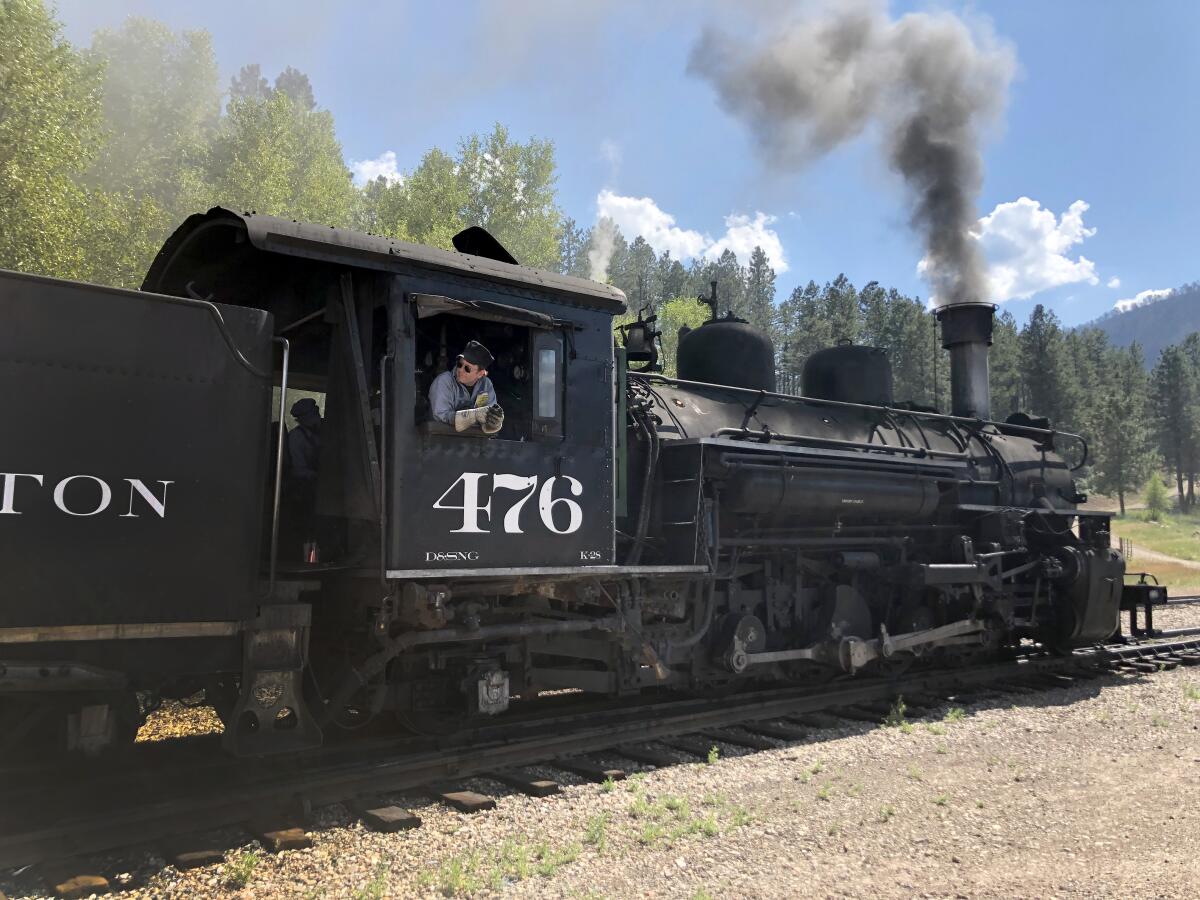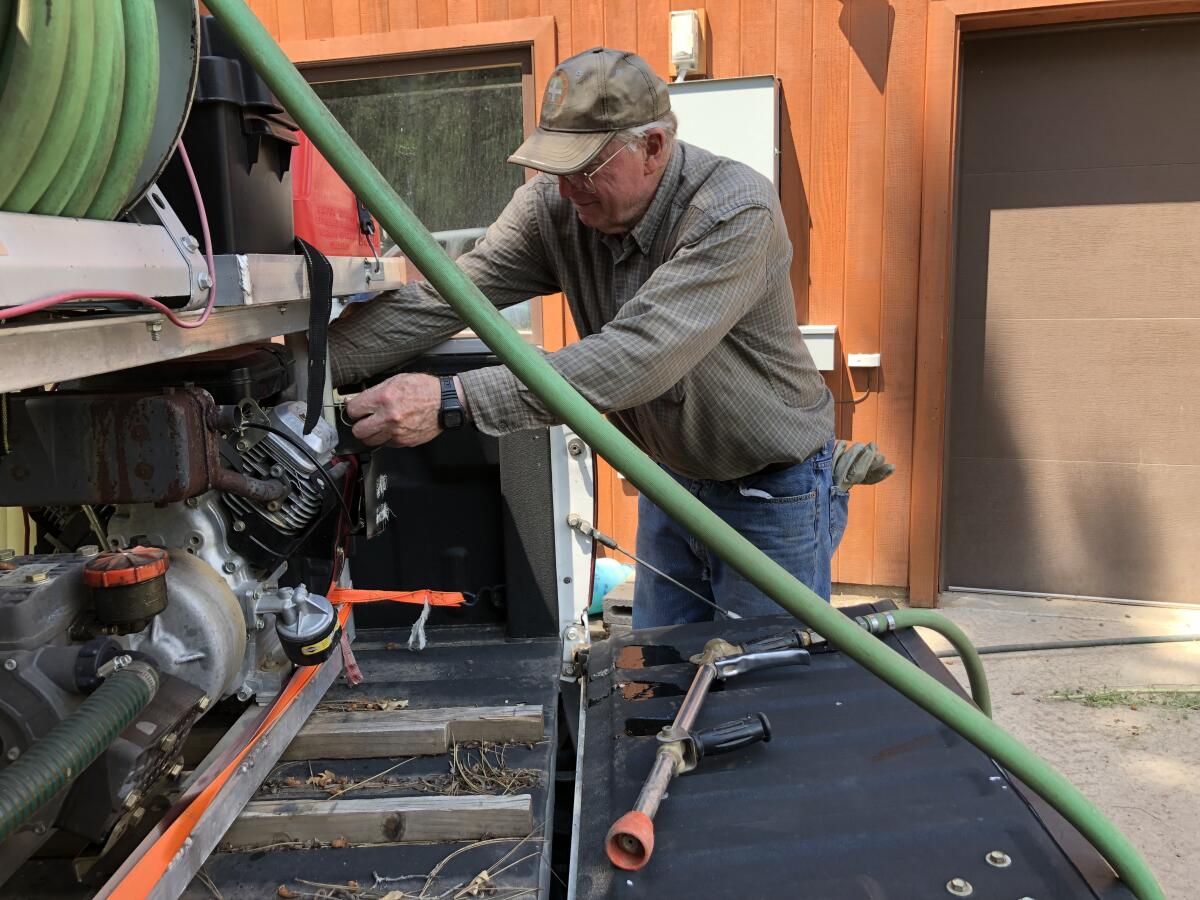After a wildfire, a Colorado town’s residents reluctantly sue a historic railway

DURANGO, Colo. — Cres Fleming got the call shortly after his neighbor spotted smoke.
He jumped into a pickup that had been converted into a water tanker and plowed through waist-high weeds to the railroad tracks.
“It took two minutes and 24 seconds,” he said. “I timed it.”
When he reached the scene, flames were rushing up the hillside.
Fleming is a 74-year-old retired chemist, not a fireman. But he’s been dousing spot fires near his house for nearly two decades. This one was different.
His water hose was too short, the winds too high.
The June 1, 2018, fire went on to torch 54,000 acres, making it the sixth-largest wildfire in Colorado history. After the blaze was contained nearly two months later, heavy rains triggered floods in the burn areas, damaging homes and businesses.

Now the federal government and others are pointing the finger at a local icon — the Durango & Silverton Narrow Gauge Railroad, which carries hundreds of thousands of passengers a year through the San Juan Mountains.
Claiming cinders from the coal-fired, steam locomotive ignited brush along the tracks during a time of heightened fire restrictions, the U.S. attorney’s office filed a suit against the train’s owners last month seeking $25 million to cover the cost of putting out the fire. Another two dozen or so citizens and businesses are also suing for damage to their properties.
Nobody wants the train to go out of business, but many fear the suits could eventually drive the railroad into bankruptcy, destroying a historic landmark and badly damaging the local economy.
Allen Harper, who owns the train, declined to comment for this story. An attorney for the railroad, Dick Waltz, said he could not talk about pending litigation.
“The responsible decision of train management would have been to not run the train in those super-dry conditions,” said Thomas Henderson, a Denver lawyer whose firm is representing individuals and businesses suing the train. “The train has started fires for years that the feds have had to put out. They should not get a free pass simply because they are big player in town. That’s not how democracy works.”
The train has run between Durango and Silverton since 1882, offering stunning alpine views and specialty trips.
And while fishing, skiing and the ancient cliff dwellings at nearby Mesa Verde are major tourist draws, the train is arguably the region’s chief economic powerhouse.
“The train’s impact is huge,” said Jack Llewellyn, executive director of the Durango Chamber of Commerce. “We have about 200,000 riders a year, and that brings in about $250 million in economic impact to the region annually.”
Few businesses are as tied to the railroad as the historic Strater Hotel, built in 1887. Roderick Barker’s family has owned it for 93 years, and he figures at least 50 to 60% of his guests ride the train.
“The train is the lifeblood of this whole town,” he said. “If it were to fail it would certainly be one of the most significant things to happen in the history of Durango.”
He believes the train caused the fire and needs to change its operations. But given its contribution to the economy, he questions why any local business would sue the railroad.
Geoffrey Schlittgen, owner of the Westerly RV Park, lost a substantial part of his summer business because of the fire.
“If I started a fire here I’d be held responsible and probably lose my business,” he said. “I don’t want the train to go out of business and I don’t think it will go out of business. But they need to take responsibility for their decisions.”
The deep communal ties to the train and its possible role in the fire have made life awkward for some here.
Bobby Duthie, an attorney, grew up on 33rd Street in Durango. The train whistle woke him each morning. He’s ridden it more than 50 times. Now he’s working with Henderson in representing those suing the train.
“I was initially reluctant to get involved because I love the train. But I also know that their decision to run it that day was reckless,” he said, sitting in his downtown office. “They had started fires on the tracks the month before and it was just a matter of time until it got out of control.”
According to the federal lawsuit, the wildfire, dubbed the 416 fire, began on Shalona Hill where the grade is steep. As the train climbed, it cast off sparks and cinders. A metal screen on the smokestack caught many but not all.
“I talked to eyewitnesses,” Duthie said. “I know the train started the fire. I’m sad they chose to run it on June 1, 2018.”
Kristi Nelson’s home escaped the fire but suffered major damage in the mudslides.
“They took 23 dump-truck loads of mud from my property,” she said. “It was devastating. I still have a mortgage on top of $116,000 worth of damages. Let’s say I don’t want to do this work. Can I sell it?”
She said people have urged her not to ruin the train. That stings for the former vice president of sales and marketing for the railroad.
“It is with a heavy heart that I entered into this lawsuit because I love the train,” she said. “But if I crashed my car into the train depot they would expect my insurance to pay. The train’s insurance should do the same.”
For its part, the railway has purchased two diesel-powered locomotives with less chance of causing fires and is making improvements to its tracks.
Cres Fleming welcomes anything that will reduce wildfires.
A self-described train fanatic, he lives in the wooded Meadowridge subdivision near the railroad tracks. Railroad crossing lights adorn his driveway. A caboose and vintage rail car stand nearby. His home has a “train room” jammed with lanterns, uniforms, bells, brass locks, milepost markers and wooden signs.
“A lot of railroad people are mad at me for saying the train caused the fire,” he said.
In fact, he said, the train routinely ignites fires.
“I have probably put out more than 50 since I moved here 19 years ago,” he said.
Fleming has converted an insecticide spraying unit into a small water tanker in the bed of a pickup. When neighbors see smoke they often call the fire department and then Fleming.
“On the morning of the fire I got there at 9:51 or 9:52ish. It took me about two minutes to get the pump online,” he said. “I dragged the hose up here and shot the water. But the hose was about 20 feet short.”
“If I arrived two minutes earlier I think I could have put it out,” he said. “I still think about it today.”
More to Read
Sign up for Essential California
The most important California stories and recommendations in your inbox every morning.
You may occasionally receive promotional content from the Los Angeles Times.










